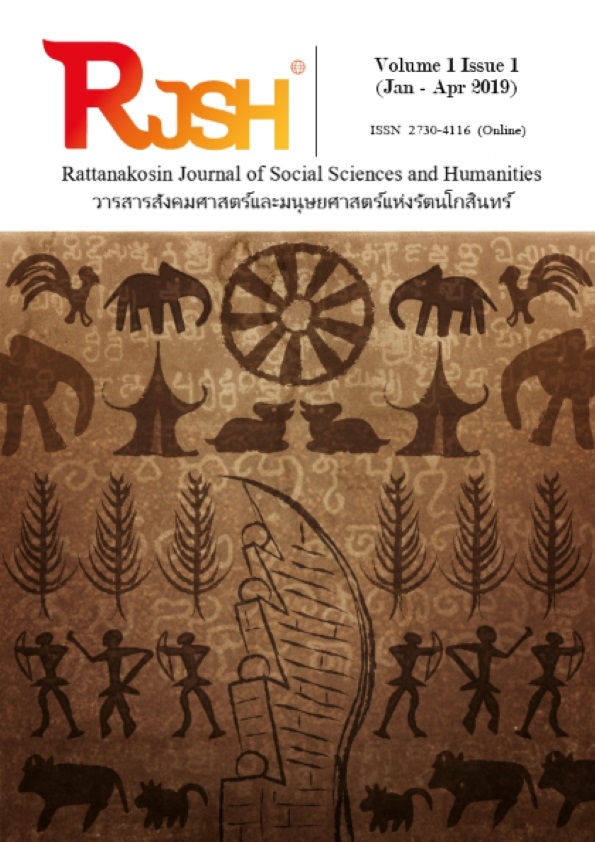งานออกแบบสื่อให้ข้อมูลผู้พิการทางสายตา กรณีศึกษาพิพิธภัณฑ์และสถานที่ท่องเที่ยวเชิงประวัติศาสตร์ในสหพันธรัฐรัสเซีย
Main Article Content
Abstract
The Russian Federation is aware of the problems and the importance of inequality for the disabled person.
By considering defend to the law to protect the rights of people with disabilities and the rights with the learning of disabled persons. Therefore, the change for the public to allow the disabled to access information and facilities. The visually impaired is one of many increasing disabilities around the world, which should have such access rights. This study is purposed to discover media design to provide information about visually impaired in museums and historical sites of the Russian Federation and set a guideline for the development of media design for the visually impaired. The study indicated that media for providing information to the visually impaired is outstanding and noticeable in museums and historical attractions because Russia has great emphasis on cultural art. From the creation of a visual replacement media with sculptural art models, architecture and painting for the visually impaired to experience both bas and round reliefs with touching the real sculpture. By incorporating with the colors and photos for the visually impaired combined with the Braille description in Russian. However, explaining the beauty and aesthetics with a physical touch from the shape may not be enough to demonstrate the delicate beauty. Since humans can be perceived through various senses then the design for the visually impaired may look at the dimension in the integration of eye perception through all the senses as much as possible. Thus, hearing, touch, smell, physical touching, including seeing have been ordered to increase the perceived potential for better understanding of the visually impaired. Accordingly, the area of media installation that is sensitive to consider both protecting valuable pieces or real objects in museums. The installation of the media in the area should have a barrier and there is a warning signal when being touched, causing the visually impaired to not be able to access the media with the limitation of perception of the area and the use of disabled space. Therefore, the use of universal design principles can solve such problems.
Article Details
The content within the published articles, including images and tables, is copyrighted by Rajamangala University of Technology Rattanakosin. Any use of the article's content, text, ideas, images, or tables for commercial purposes in various formats requires permission from the journal's editorial board.
Rajamangala University of Technology Rattanakosin permits the use and dissemination of article files under the condition that proper attribution to the journal is provided and the content is not used for commercial purposes.
The opinions and views expressed in the articles are solely those of the respective authors and are not associated with Rajamangala University of Technology Rattanakosin or other faculty members in the university. The authors bear full responsibility for the content of their articles, including any errors, and are responsible for the content and editorial review. The editorial board is not responsible for the content or views expressed in the articles.
References
ทอปัด วงษาลังการ. (2559) การศึกษาปัญหาในการใช้สื่อการสอนของผู้พิการทางสายตา มูลนิธิช่วยคนตาบอดแห่งประเทศไทยในพระบรมราชินูปถัมภ์. มหาวิทยาลัยเทคโนโลยีราชมงคลรัตนโกสินทร์
องค์อร วงษาลังการ (2554) การใช้ตัวอักษรและสัญลักษณ์ในงานออกแบบนิเทศศิลป์เพื่อรองรับผู้พิการทางสายตา ประเภทเห็นเลือนราง Veridian E-Journal,Silpakorn University (Humanities, Social Sciences and arts) Vol 4 No 1: May-August 2011
Bentzen, B.L., Nolin, T.L. & Easton, R.D. (1994a). Detectable warning surfaces: Color, contrast and reflectance. Cambridge, MA: U.S. Department of Transportation, Federal Transit Administration, Volpe National Transportation Systems Center. Report No. VNTSC-DTRS-57-93-P-80546.
Human Rights Watch. 2014. Russia: Pass Laws to Protect Disability Rights. May 11, 2014 Human Rights Watch: from https://www.hrw.org/news/2014/05/11/russia-pass-laws-protect-disability-rights. Accessed December 1, 2018
World Health Organization. (2001). International Classification of Functioning, Disability and Health (ICF), World Health Organization, Geneva.


